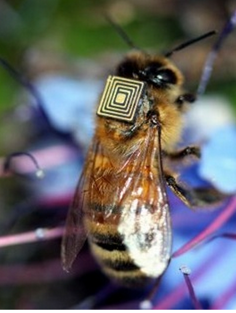More bee science
« previous post | next post »
 "Why Is This Bee Wearing a Sensor? Also, how did scientists get that sensor onto the bee in the first place?", The Atlantic 1/16/2014:
"Why Is This Bee Wearing a Sensor? Also, how did scientists get that sensor onto the bee in the first place?", The Atlantic 1/16/2014:
Australian scientists have devised a way to pinpoint the causes of the global die-off of bees that pollinate a third of the world’s crops: Attach tiny sensors to 5,000 honey bees, and follow where they fly.
The sensors, each measuring 2.5 millimeters by 2.5 millimeters (0.1 inch by 0.1 inch), contain radio frequency identification chips that broadcast each bee’s location in real-time. The data is beamed to a server, so scientists can construct a three-dimensional model of the swarm’s movements, identifying anomalies in their behavior.
Worker bees tend to follow predictable daily schedules—they don’t call them drones for nothing—leaving the beehive at certain times, foraging for pollen, and returning home along well-established routes. Variations in their routines may indicate a change in environment, such as exposure to pesticides.
I was happy to see this story, given my long-standing interest in Bee Science — but I can't avoid pointing out a slight terminological problem with the coverage. Worker bees are reproductively inactive females; "drones" are males, who do no work. Drones don't even feed themselves, but are tended by worker bees. Their only real function, as Wikipedia explains,
… is to be ready to fertilize a receptive queen. Drones in a hive do not usually mate with a virgin queen of the same hive because they drift from hive to hive. Mating generally takes place in or near drone congregation areas. It is poorly understood how these areas are selected, but they do exist. When a drone mates with his sister, the resultant queen will have a spotty brood pattern (numerous empty cells on a brood frame). This is due to the removal of diploid drone larvae by nurse bees (i.e., a fertilized egg with two identical sex genes will develop into a drone instead of a worker).
Mating occurs in flight, which accounts for the need of the drones for better vision, which is provided by their large eyes. Should a drone succeed in mating he soon dies because the penis and associated abdominal tissues are ripped from the drone's body after sexual intercourse.
Without this knowledge, it's impossible to understand the writings of P.G. Wodehouse, who created the most famous drone congregation area in English fiction:
The Drones Club is a recurring fictional location in the stories of British comic writer P. G. Wodehouse. […] The Drones Club is in Mayfair, London, located in Dover Street, off Piccadilly. A drone being a male bee that does no work, living off the labour of others, it aptly describes the contemporary Edwardian stereotype of rich, idle young club members.
I worry about our culture. First Swift, now Wodehouse…
Nathan said,
January 17, 2014 @ 4:05 pm
Most people think Jeeves was a butler, too.
Rubrick said,
January 17, 2014 @ 4:30 pm
To quote myself: "They don't call me 'Mr. Sensational' for nothing — or, indeed, at all."
Carrington Dixon said,
January 17, 2014 @ 4:51 pm
Most people in the US don't understand the distinction between 'butler' and 'valet'. They are apt to treat the two words as synonyms — especially in casual conversation.
Ray Girvan said,
January 17, 2014 @ 4:55 pm
"Drones" always make me think of TE Brown's overheard diatribe against parsons, in Anglo-Manx dialect:
Jeff DeMarco said,
January 18, 2014 @ 12:44 pm
Makes you wonder why they used the term for unpeopled aircraft.
MikeA said,
January 18, 2014 @ 4:23 pm
@Jeff DeMarco
Perhaps because "drones" initially lacked a stinger?
mollymooly said,
January 23, 2014 @ 11:28 am
@Jeff DeMarco
Google suggests one or both of
this:
and/or this: